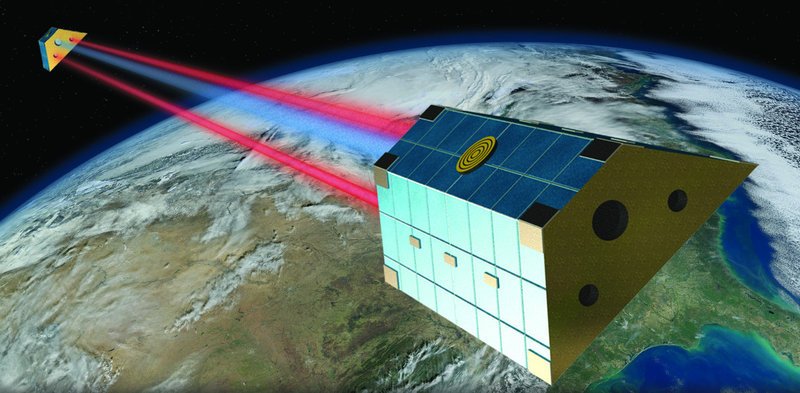U.S./Germany GRACE-FO: Tandem Of Two Satellites Lifted Off To Track Earth’s Water Movement
Two satellites will track the continuous movement of water and other changes in Earth’s mass on and beneath the planet’s surface .
A joint U.S./German space mission – the twin spacecraft of the Gravity Recovery and Climate Experiment Follow-On (GRACE-FO) – successfully launched at 12:47 p.m. PDT (3:47 p.m. EDT) Tuesday from the California coast and initial telemetry shows the satellites are performing as expected.

GRACE Follow-On will be a tandem of two satellites, circling the Earth separated by 220 kilometers in the same orbit 490 kilometers above ground. It will measure inter-satellite distances with microwaves (blue) and a new laser interferometer (red). © Earth: NASA “Blue Marble”, satellites: Schütze/AEI
The GRACE-FO satellites are at an altitude of about 305 miles (490 kilometers), traveling about 16,800 mph (7.5 kilometers per second). They are in a near-polar orbit, circling Earth once every 90 minutes. While it takes the satellites above Earth’s poles, the planet rotates below the pair of satellites so that over time they fly over the entire surface of Earth.
“GRACE-FO will provide unique insights into how our complex planet operates,” said Thomas Zurbuchen, associate administrator of NASA’s Science Mission Directorate at NASA Headquarters in Washington.
Artist’s view of the GRACE Follow-on mission (image credit: Astrium)
Artist’s view of the GRACE Follow-on mission (image credit: Astrium)
“Just as important, because the mission monitors many key aspects of the Earth’s water cycle, GRACE-FO data will be used throughout the world to improve people’s lives — from better predictions of drought impacts to higher-quality information on use and management of water from underground aquifers.”
The satellites continuously register their distance with high precision. The fine structure of the Earth’s gravity field modulates this distance. During, e.g., flying over the Himalayas the distance changes by 40 millionths of a meter. To detect such tiny effects, a microwave interferometer similar to radar has been used so far.
Over its five-year mission, GRACE-FO will monitor the movement of mass around our planet by measuring where and how the moving mass changes Earth’s gravitational pull.
The gravity changes cause the distance between the two satellites to vary slightly. Although the two satellites orbit 137 miles (220 kilometers) apart, advanced instruments continuously measure their separation to within the width of a human red blood cell.
“I am relieved that the launch went perfect. In a few days we will switch on the laser interferometer from Oberpfaffenhofen and soon after that establish the laser link between the two satellites. This is going to be very exciting!” says Prof. Gerhard Heinzel, leader of the space interferometry research group at the AEI and manager of the German contribution to the Laser Ranging Interferometer (LRI).
GRACE-FO is the improved successor to the successful GRACE mission which operated from 2002 to 2017.
“Extending the data record from GRACE will allow us to better distinguish short-term variability from longer-term trends,” Frank Webb, GRACE-FO project scientist at NASA’s Jet Propulsion Laboratory in Pasadena, California, said.
The GRACE-FO satellites will spend their first few days in space moving to the separation distance needed to perform their mission.
When they reach this distance, the mission will begin an 85-day, in-orbit checkout phase. After evaluation of the instruments and satellite systems and other important procedures, the satellites will begin gathering and processing science data.
The first science data are expected to be released in about seven months.



 Creators of mankind
Creators of mankind Description of “Tall white aliens”
Description of “Tall white aliens” Where they came from?
Where they came from? About hostile civilizations
About hostile civilizations The war for the Earth
The war for the Earth “Tall white aliens” about eternal life
“Tall white aliens” about eternal life Video: “Nordic aliens”
Video: “Nordic aliens” Aliens
Aliens Alien encounters
Alien encounters The aliens base
The aliens base UFO
UFO Technology UFO
Technology UFO Underground civilization
Underground civilization Ancient alien artifacts
Ancient alien artifacts Military and UFO
Military and UFO Mysteries and hypotheses
Mysteries and hypotheses Scientific facts
Scientific facts


















